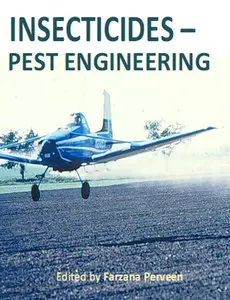"Insecticides - Pest Engineering" ed. by Farzana Perveen
ITAe | 2012 | ISBN: 9533078952 9789533078953 | 459 pages | PDF | 24 MB
ITAe | 2012 | ISBN: 9533078952 9789533078953 | 459 pages | PDF | 24 MB
This book is compiled of 24 Chapters divided into 4 Sections. The subject matter in this book should attract the reader's concern to support rational decisions regarding the use of pesticides.
Section A focuses on toxicity of organic and inorganic insecticides, organophosphorus insecticides, toxicity of fenitrothion and permethrin, and dichlorodiphenyltrichloroethane (DDT).
Section B is dedicated to vector control using insecticides, biological control of mosquito larvae by Bacillus thuringiensis, metabolism of pyrethroids by mosquito cytochrome P40 susceptibility status of Aedes aegypti, etc.
Section C describes bioactive natural products from sapindacea, management of potato pests, flower thrips, mango mealy bug, pear psylla, grapes pests, small fruit production, boll weevil and tsetse fly using insecticides.
Section D provides information on insecticide resistance in natural population of malaria vector, role of Anopheles gambiae P450 cytochrome, genetic toxicological profile of carbofuran and pirimicarp carbamic insecticides, etc.
Contents
Part 1 Insecticides Mode of Action
1 Insecticide
2 Chlorfluazuron as Reproductive Inhibitor
3 Organophosphorus Insecticides and Glucose Homeostasis
4 The Toxicity of Fenitrothion and Permethrin
5 DDT and Its Metabolites in Mexico
6 Presence of Dichlorodiphenyltrichloroethane (DDT) in Croatia and Evaluation of Its Genotoxicity
Part 2 Vector Management
7 Vector Control Using Insecticides
8 Susceptibility Status of Aedes aegypti to Insecticides in Colombia
9 Behavioral Responses of Mosquitoes to Insecticides
10 Essential Plant Oils and Insecticidal Activity in Culex quinquefasciatus
11 Biological Control of Mosquito Larvae by Bacillus thuringiensis subsp. israelensis
12 Metabolism of Pyrethroids by Mosquito Cytochrome P450 Enzymes: Impact on Vector Control
Part 3 Pest Management
13 Bioactive Natural Products from Sapindaceae Deterrent and Toxic Metabolites Against Insects
14 Pest Management Strategies for Potato Insect Pests in the Pacific Northwest of the United States
15 Management of Tuta absoluta (Lepidoptera, Gelechiidae) with Insecticides on Tomatoes
16 Management Strategies for Western Flower Thrips and the Role of Insecticides
17 The Past and Present of Pear Protection Against the Pear Psylla, Cacopsylla pyri L.
18 Effects of Kaolin Particle Film and Imidacloprid on Glassy-Winged Sharpshooter (Homalodisca vitripennis ) (Hemiptera: Cicadellidae) Populations and the Prevention of Spread of Xylella fastidiosa in Grape
19 Use and Management of Pesticides in Small Fruit Production
20 The Conundrum of Chemical Boll Weevil Control in Subtropical Regions
21 Management of Tsetse Fly Using Insecticides in Northern Botswana
Part 4 Toxicological Profile of Insecticides
22 Trends in Insecticide Resistance in Natural Populations of Malaria Vectors in Burkina Faso, West Africa: 10 Years' Surveys
23 The Role of Anopheles gambiae P450 Cytochrome in Insecticide Resistance and Infection
24 Genetic Toxicological Profile of Carbofuran and Pirimicarb Carbamic Insecticides
with TOC BookMarkLinks



